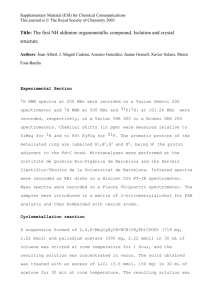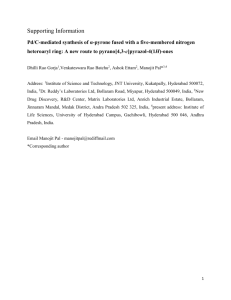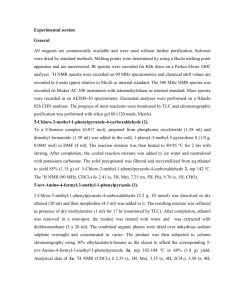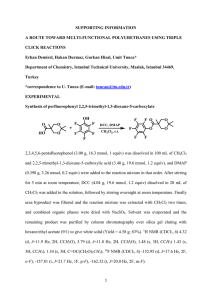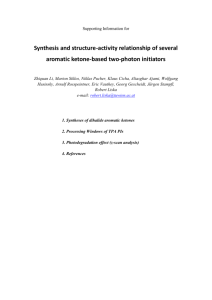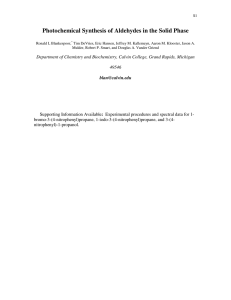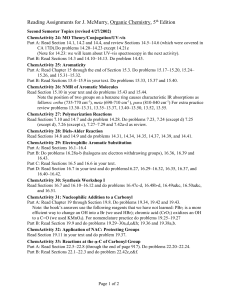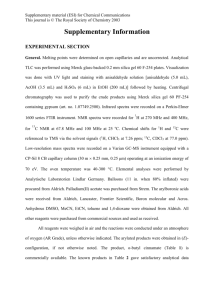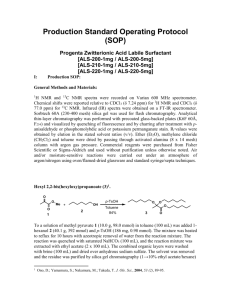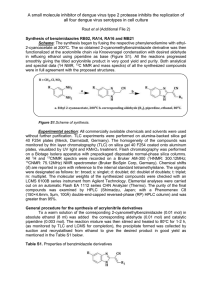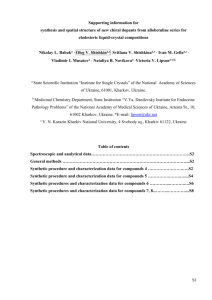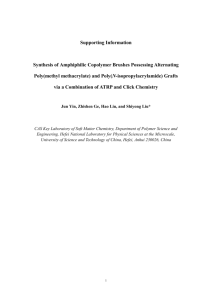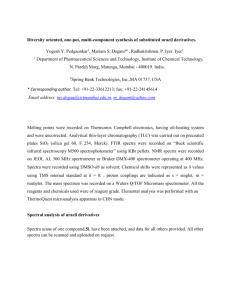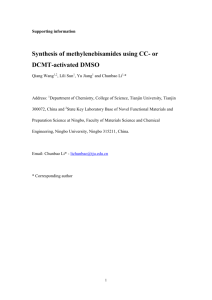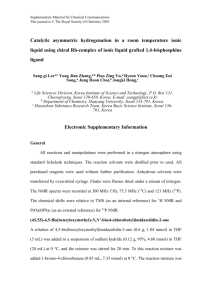and 4-vinylbenzyl chloride (5.18 g, 34 mmol) in DMF (75 mL)
advertisement
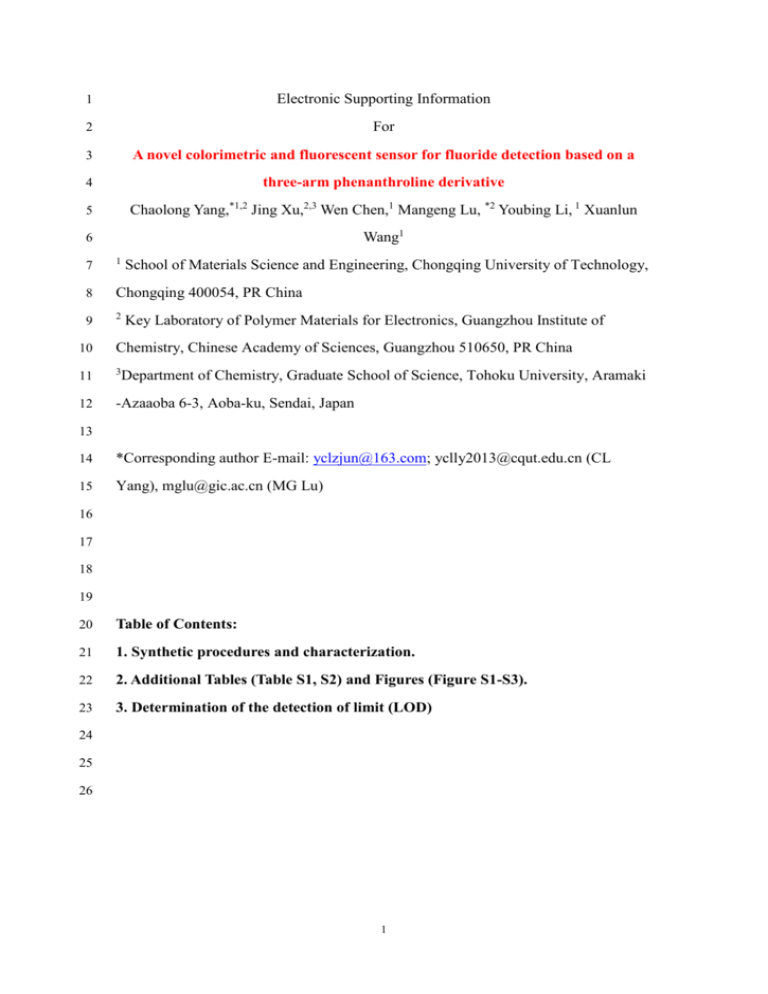
1 Electronic Supporting Information 2 For 3 A novel colorimetric and fluorescent sensor for fluoride detection based on a 4 three-arm phenanthroline derivative 5 Chaolong Yang,*1,2 Jing Xu,2,3 Wen Chen,1 Mangeng Lu, *2 Youbing Li, 1 Xuanlun 6 Wang1 7 1 8 Chongqing 400054, PR China 9 2 School of Materials Science and Engineering, Chongqing University of Technology, Key Laboratory of Polymer Materials for Electronics, Guangzhou Institute of 10 Chemistry, Chinese Academy of Sciences, Guangzhou 510650, PR China 11 3 12 -Azaaoba 6-3, Aoba-ku, Sendai, Japan Department of Chemistry, Graduate School of Science, Tohoku University, Aramaki 13 14 *Corresponding author E-mail: yclzjun@163.com; yclly2013@cqut.edu.cn (CL 15 Yang), mglu@gic.ac.cn (MG Lu) 16 17 18 19 20 Table of Contents: 21 1. Synthetic procedures and characterization. 22 2. Additional Tables (Table S1, S2) and Figures (Figure S1-S3). 23 3. Determination of the detection of limit (LOD) 24 25 26 1 27 28 Scheme S1 Synthetic procedure of desired receptor trisphen. 29 30 1. Synthetic procedures and characterization. 31 Synthesis of 1, 3, 5-tris(bromomethyl)- 2, 4, 6-trimethylbenzene 32 1, 3, 5-tris(bromomethyl)- 2, 4, 6-trimethylbenzene was prepared according to the 33 procedure described in the literature with some modification [1]. Mesitylene (12 g, 34 100 mmol), paraformaldehyde (10.26 g, 340 mmol) and 75 ml of glacial acetic acid 35 was rapidly added to a 150 ml three neck round bottom flask with 75 ml of HBr/acetic 36 acid solution during magic stirring. The mixture solution was heated to 95 oC and kept 37 at this temperature for 8 h, then poured into 200 ml of water to give amounts of white 38 solid. The product from filtering was washed with 200 ml of anhydrous ethanol, and 39 then was filtered and dried overnight at 60 oC to give 33.5 g of title compound, yield 40 85%, mp 183-186 oC. FT-IR (KBr) (cm-1): 785, 1446.1, 2922. 1H NMR (400 MHz, 41 CDCl3): δ 2.44 (s, 9H, Ar-CH3), 4.56(s, 6H,-CH2Br). 42 δ12.1, 27.5, 134.7, 137.1. 43 Synthesis of 1,10-phenanthroline-5,6-Dione. 44 1,10-phenanthroline-5,6-dione was synthesized according to a modified literature 45 procedure [2]. 1,10-phenanthroline monohydrate (10.16g, 51.3 mmol) and KBr (24.94 46 g, 209.6 mmol) were added in a 250 ml three-neck round-bottom flask with a reflux 47 condenser, mixture acid of 75 ml concentrated sulfuric acid and 35 ml concentrated 2 13 C NMR (100 MHz, CDCl3): 48 nitric acid was added rapidly during stirring, after the mixture acid finished, solution 49 was heated to 125 oC and kept at this temperature for 3 h. After 3 h, heating 50 temperature was reduced to 100 oC, and the reflux condenser was removed to allow 51 bromine vapors escape from the reaction flask, and used the 10 M NaOH solution 52 absorbed the bromine. After being cooled, the mixture was poured into 275 g ice and 53 carefully neutralized to pH = 7 with 5 M sodium hydroxide solution, and cooled to 54 room temperature. Then the yellow turbid solution was filtered, and residual solid was 55 washed four times with 30 ml boiling water every time, and the filtrate was collected. 56 The combined aqueous solution was extracted with 200 ml dichloromethane, dried 57 over anhydrous magnesium sulfate, and evaporated under reduced pressure to give 58 light-yellow solid. The crude product was recrystallized from 250 ml of toluene to 59 give the yellow needle crystalline. The pure product was dried overnight in vacuum at 60 60 oC, yield 80%. Mp: 253-256 oC. FT-IR (KBr) /cm-1: 3062, 1685, 1576, 1561, 61 1460, 1414, 1314, 1292, 1205, 1115, 1009, 924, 808, 738. 62 CDCl3), δ: 7.58(d, 16 Hz, 2H), 8.50(dd, 8 Hz, 2H), 9.11(dd, 8 Hz, 2H). 63 1,3,5-Tris(4-formylphenoxymethyl)-2,4,6-trimethylbenzene. 64 4-hydroxybenzaldehyde (4.2 g, 40 mmol), 1,3,5-tris(2-bromomethyl)-2,4,6-trimethyl- 65 benzene (4.0 g, 10 mmol), and potassium carbonate (5.52 g, 20 mmol) were dissolved 66 in 100 ml DMF, and reacted at 90 oC for 24 h. The resulting solution was poured into 67 600 ml water, then filtered to get white solid, washed with large portion of water and 68 ethanol, then the resulting solid was recrystallized from a mixture of acetic ether to 69 give fine white crystals (4.88 g, 93%). 1H NMR (CDCl3, 400 MHz, ppm): 2.47 (9H, s, 70 3×CH3), 5.22 (6H, s, 3× CH2), 7.13 (6H, d, aromatic), 7.89 (6H, d, aromatic), 9.93 71 (3H, s, 3×CHO);13 C NMR (CDCl3 , 100 MHz, ppm): 16.42 (CH3), 65.67 (CH2), 72 115.28, 132.48 (aromatic), 130.75, 131.68, 140.16, 164.34 (quaternary aromatic), 73 191.11 (CHO); MS (ESI) m/z = 523.3 (M+H) + . FT-IR (KBr) υ(C=O) 1691 cm-1 . 1 H NMR (400 MHz 74 75 References 76 [1] AW van der Made and RH van der Made. A convenient procedure for 77 bromomethylation of aromatic compounds. 3 Selective mono-, bis-, or 78 trisbromomethylation. J Org Chem 1993; 58: 1262-1263. 79 [2] 80 and .LAMBDA.-[Ru(phen)2DPPZ]2+. J Am Chem Soc 1993; 115: 3448-3454. Hiort C, Lincoln P and Norden B. DNA binding of .DELTA.- 81 82 83 84 85 86 87 88 2. Additional Figures (Figure S1-S4). 89 90 Figure S1 UV-Vis absorption spectra of receptor trisphen (1×10-5 M) upon addition of 91 different anions (3×10-5 M of F-, CH3COO-, H2PO4-, Cl-, Br-, I-, HSO4- and NO3-) in 92 DMSO. 4 93 94 Figure S2 Fluorescent emission spectra of trisphen in the presence of different 95 concentrations (0-2.1×10-3 M) of AcO- ion in DMSO solution. 96 97 98 Figure S3 The emission spectra changes of 5×10-4 M AcO- bonded trisphen with the 99 addition of 5 and 10% water (ethanol). 5 100 101 Figure S4 The changes of 1HNMR spectra for trisphen upon the addition of differen 102 concentration AcO-. 103 104 105 106 107 3. Determination of the detection of limit (LOD) 108 The LOD of receptor trisphen was determined from the following equation: 109 LOD = K*SD/S 110 Where K = 3; SD is the standard deviation of the blank solution; S is the slope of the 111 calibration curve. 112 6 113 Figure S5 A plot of (A0-A ) vs F- concentrations at 321 nm. 114 115 Y=A+B*X 116 117 Parameter 118 ------------------------------------------------------------ 119 A -0.00201 120 B 612.9 121 ------------------------------------------------------------ 122 R 123 ------------------------------------------------------------ 124 0.99589 0.00102 5 125 ------------------------------------------------------------ SD N Value Error 0.00107 32.18794 P 3.1629E-4 126 7 127 Figure S6 A plot of (A0-A ) vs AcO- concentrations at 321 nm. 128 129 130 Y=A+B*X 131 132 Parameter Value Error 133 ------------------------------------------------------------ 134 A 0.00201 3.77688E-4 135 B 553.8 136 ------------------------------------------------------------ 11.38771 137 138 R SD N P 139 ------------------------------------------------------------ 140 0.99937 3.60111E-4 5 141 ------------------------------------------------------------ <0.0001 142 8





